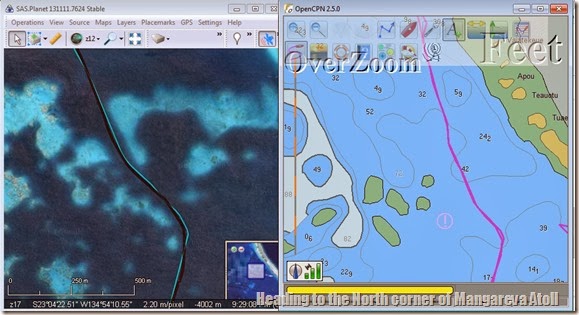Eolian's masts are canted aft. This means that, if the booms are to be aesthetically and pleasingly level, the angles between the foot and the luff of the main and mizzen sails must be less than 90°. Our mainsail was correctly built, but the mizzen was not. Whether it was incorrectly built for the boat (unlikely), or it was an adapted mainsail (more likely), the cut of the mizzen sail was such that the boom drooped.
Further, flying where it does in the dirty air behind the main, the mizzen needs to have less draft than the mainsail so that it will fill properly. In another indication that our mizzen is a re-purposed mainsail, it had a lot of draft.
One of the reasons for our acquisition of our Sailrite LSZ-1 was to reshape the mizzen. And in particular the "Z" part, since this model does the zig-zag stitching that sails use. So, an afternoon's project: recut the mizzen.
Before removing the sail from the boat, I measured (using a steel, non-stretchy tape measure) the leech of the sail when sheeted in. Then I raised the boom to where I thought it should be and remeasured the leech. The difference was about 7".
Next, with the sail on the floor at our cabin, I arranged it so that I could take a wedge-shaped piece of cloth out of the lowest seam, one that had no "complications", like a batten pocket or a second clew for reefing. This was non-trivial - even tho it is a mizzen, the sail is pretty big, with a luff of 32 feet and a foot of 11 feet. It just barely fit on the floor, with all the furniture moved away.
 |
| Tight squeeze |
 |
| No going back now. |
Then, allowing a 1" seam allowance, I trimmed away the long wedge-shaped piece of cloth from the lower panel.
Now all I had to do was put it back together. My first attempt failed. I simply could not manage all that cloth and keep the seam lined up.
 |
| A cloth management problem |
And this time I spent more time to carefully line things up. I found that the draft in the sail was created on the bottom of the upper panel - the top of the bottom panel (to the right in the pictures) had been straight, and remained so since I used the chalk line. But when lining things up with the basting tape, I did not honor the 1" seam allowance I had granted myself, since that would have recreated the draft. Instead I just pulled the seam straight. In the center of the sail, it turned out that I had 2.5" of seam.
The only tricky part was at the leech, where I had to be very careful to handle the triple-folded surface and keep the leech line from getting sewed in place. Well that's not quite true. Managing all that cloth is a real problem. You can see that my carefully-flaked upper portion of the sail did not long survive. It is important to allow the sewing machine to move the fabric, and that requires two handlers, one on each side of the seam, to keep a little slack in front of the presser foot, and to move the sewed section away from the back of the presser foot. The sail is heavy and bulky; keeping that little bit of slack was not easy.
I triple-stitched the seam using Helios thread. I see no reason to use anything but the lifetime-guaranteed teflon thread for any kind of outdoor work.
With the sail back on the boat, the boom hangs where I had hoped, and the sail is a lot flatter. Now all I need is for the seasons to advance enough to take it out on the Sound and see how it looks when it is full of wind...



















